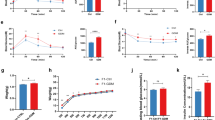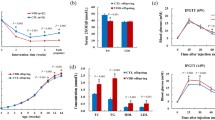Abstract
Aims/hypothesis
We aimed to investigate the impact of maternal vitamin D deficiency during pregnancy on insulin resistance in male offspring and examine its mechanism.
Methods
Pregnant Sprague–Dawley rats were maintained on a vitamin-D-free diet with ultraviolet-free light during pregnancy (early-VDD group). Insulin resistance in the male offspring was assessed by HOMA-IR, OGTT and euglycaemic clamp. NEFA, oxidative stress and inflammation levels were estimated as risk factors for insulin resistance. DNA methylation was examined by bisulfate sequencing PCR analysis. Luciferase reporter assay was performed to validate the effect of DNA methylation.
Results
The offspring in the early-VDD group had significantly higher fasting insulin and HOMA-IR levels, markedly reduced glucose tolerance and significantly lower tissue sensitivity to exogenous insulin at 16 weeks (all p < 0.05) compared with control offspring. Significantly higher serum and liver IL-1β, IL-6, IL-8 and TNF-α concentrations were observed in the offspring of the early-VDD group at 0, 3, 8 and 16 weeks. Expression of hepatic Iκbα (also known as Nfkbia) mRNA and nuclear factor κB inhibitor α (IκBα) protein was persistently lower in the early-VDD offspring at all time points, and their hepatic Iκbα methylation levels at the cytosine phosphate guanine site +331 were significantly higher at 0 and 16 weeks (all p < 0.01). Methylation at Iκbα first exon +331 markedly decreased the luciferase activity (p < 0.05).
Conclusions/interpretation
Maternal vitamin D deficiency during pregnancy results in insulin resistance in the offspring, which is associated with persistently increased inflammation. Persistently decreased Iκbα expression, potentially caused by changes in Iκbα methylation, plays an important role in persistent inflammation.






Similar content being viewed by others
Abbreviations
- 1,25(OH)D:
-
1,25-Dihydroxyvitamin D
- 25(OH)D:
-
25-Hydroxyvitamin D
- CpG:
-
Cytosine phosphate guanine
- Early-VDD:
-
Early-life vitamin D deficiency
- FG:
-
Fasting glucose
- FIN:
-
Fasting insulin
- GIR:
-
Glucose infusion rate
- GSH-Px:
-
Glutathione peroxidase
- IκBα:
-
NFκB inhibitor α
- IKK:
-
NFκB inhibitor kinase
- IR:
-
Insulin resistance
- MDA:
-
Malonaldehyde
- NFκB:
-
Nuclear factor κB
- P-IκBα:
-
Phosphorylated NFκB inhibitor α
- PTH:
-
Parathyroid hormone
- ROS:
-
Reactive oxygen species
- SOD:
-
Superoxide dismutase
- TG:
-
Triacylglycerol
References
Vaidya A, Forman JP (2010) Vitamin D and hypertension: current evidence and future directions. Hypertension 56:774–779
Pilz S, Tomaschitz A, Marz W et al (2011) Vitamin D, cardiovascular disease and mortality. Clin Endocrinol 75:575–584
Martini LA, Wood RJ (2006) Vitamin D status and the metabolic syndrome. Nutr Rev 64:479–486
Holick MF (2011) Vitamin D: evolutionary, physiological and health perspectives. Curr Drug Targets 12:4–18
Hollis BW, Wagner CL (2006) Vitamin D deficiency during pregnancy: an ongoing epidemic. Am J Clin Nutr 84:273
Gluckman PD, Hanson MA, Cooper C, Thornburg KL (2008) Effect of in utero and early-life conditions on adult health and disease. N Engl J Med 359:61–73
Weishaar RE, Simpson RU (1987) Involvement of vitamin D3 with cardiovascular function. II. Direct and indirect effects. Am J Physiol 253:E675–E683
Sorensen IM, Joner G, Jenum PA, Eskild A, Torjesen PA, Stene LC (2012) Maternal serum levels of 25-hydroxy-vitamin D during pregnancy and risk of type 1 diabetes in the offspring. Diabetes 61:175–178
Vaiserman AM, Carstensen B, Voitenko VP et al (2007) Seasonality of birth in children and young adults (0-29 years) with type 1 diabetes in Ukraine. Diabetologia 50:32–35
Clark SA, Stumpf WE, Sar M (1981) Effect of 1,25 dihydroxyvitamin D3 on insulin secretion. Diabetes 30:382–386
Nagpal J, Pande JN, Bhartia A (2009) A double-blind, randomized, placebo-controlled trial of the short-term effect of vitamin D3 supplementation on insulin sensitivity in apparently healthy, middle-aged, centrally obese men. Diabet Med 26:19–27
Lu L, Yu Z, Pan A et al (2009) Plasma 25-hydroxyvitamin D concentration and metabolic syndrome among middle-aged and elderly Chinese individuals. Diabetes Care 32:1278–1283
Chiu KC, Chu A, Go VL, Saad MF (2004) Hypovitaminosis D is associated with insulin resistance and beta cell dysfunction. Am J Clin Nutr 79:820–825
Burdge GC, Slater-Jefferies J, Torrens C, Phillips ES, Hanson MA, Lillycrop KA (2007) Dietary protein restriction of pregnant rats in the F0 generation induces altered methylation of hepatic gene promoters in the adult male offspring in the F1 and F2 generations. Br J Nutr 97:435–439
Klose RJ, Bird AP (2006) Genomic DNA methylation: the mark and its mediators. Trends Biochem Sci 31:89–97
Gluckman PD, Hanson MA, Beedle AS (2007) Non-genomic transgenerational inheritance of disease risk. Bioessays 29:145–154
Uwaifo GI, Fallon EM, Chin J, Elberg J, Parikh SJ, Yanovski JA (2002) Indices of insulin action, disposal, and secretion derived from fasting samples and clamps in normal glucose-tolerant black and white children. Diabetes Care 25:2081–2087
Li L, Oshida Y, Kusunoki M et al (1999) Rat C peptide I and II stimulate glucose utilization in STZ-induced diabetic rats. Diabetologia 42:958–964
Niu Y, Na L, Feng R et al (2013) The phytochemical, EGCG, extends lifespan by reducing liver and kidney function damage and improving age-associated inflammation and oxidative stress in healthy rats. Aging Cell 12:1041–1049
Folch J, Lees M, Sloane Stanley GH (1957) A simple method for the isolation and purification of total lipids from animal tissues. J Biol Chem 226:497–509
Lu N, Li Y, Qin H, Zhang YL, Sun CH (2008) Gossypin up-regulates LDL receptor through activation of ERK pathway: a signaling mechanism for the hypocholesterolemic effect. J Agric Food Chem 56:11526–11532
Dokken BB, Saengsirisuwan V, Kim JS, Teachey MK, Henriksen EJ (2008) Oxidative stress-induced insulin resistance in rat skeletal muscle: role of glycogen synthase kinase-3. Am J Physiol Endocrinol Metab 294:E615–E621
McGarry JD (2002) Banting lecture 2001: dysregulation of fatty acid metabolism in the etiology of type 2 diabetes. Diabetes 51:7–18
Shoelson SE, Lee J, Goldfine AB (2006) Inflammation and insulin resistance. J Clin Invest 116:1793–1801
Novakovic B, Yuen RK, Gordon L et al (2011) Evidence for widespread changes in promoter methylation profile in human placenta in response to increasing gestational age and environmental/stochastic factors. BMC Genomics 12:529
Wang T, Zhang X, Li JJ (2002) The role of NF-kappaB in the regulation of cell stress responses. Int Immunopharmacol 2:1509–1520
Siomek A (2012) NF-kappaB signaling pathway and free radical impact. Acta Biochim Pol 59:323–331
Cao L, Gao H, Gui S et al (2014) Effects of the estrogen receptor antagonist fulvestrant on F344 rat prolactinoma models. J Neuro-Oncol 116:523–531
Li Y, Xiao D, Yang S, Zhang L (2013) Promoter methylation represses AT2R gene and increases brain hypoxic-ischemic injury in neonatal rats. Neurobiol Dis 60:32–38
Baccarelli A, Bollati V (2009) Epigenetics and environmental chemicals. Curr Opin Pediatr 21:243–251
Mazzio EA, Soliman KF (2014) Epigenetics and nutritional environmental signals. Integr Comp Biol 54:21–30
Liu X, Zhang P, Bao Y et al (2013) Zinc finger protein ZBTB20 promotes Toll-like receptor-triggered innate immune responses by repressing IkappaBalpha gene transcription. Proc Natl Acad Sci U S A 110:11097–11102
Brenet F, Moh M, Funk P et al (2011) DNA methylation of the first exon is tightly linked to transcriptional silencing. PLoS One 6:e14524
Brookes E, Pombo A (2009) Modifications of RNA polymerase II are pivotal in regulating gene expression states. EMBO Rep 10:1213–1219
Acknowledgements
We thank J. Li (Department of Nutrition and Food Hygiene, Public Health College, Harbin Medical University, Harbin, China) for helping with the revision and L. Y. Gong and J. N. Song (Department of Nutrition and Food Hygiene, Public Health College, Harbin Medical University) for their help with animal feeding and molecular biology experiments.
Funding
This study was supported by the State Key Program of National Natural Science of China (No. 81130049), the National ‘Twelfth Five-Year’ Plan for Science & Technology Support (No. 2012BAI02B02) and the Program for New Century Excellent Talents in University of Ministry of Education of China (grant NCET-10-0148).
Duality of interest
The authors declare that there is no duality of interest associated with this manuscript.
Contribution statement
CS and YL designed the study, analysed and interpreted the data and reviewed and edited the manuscript. HZ designed and performed the study, acquired and analysed the data and wrote the draft of the manuscript. XC, YH, GL and YW were responsible for performing the study, data collection and interpretation and drafting the manuscript. All authors approved the final version of the manuscript. CS is responsible for the integrity of the work as a whole.
Author information
Authors and Affiliations
Corresponding authors
Electronic supplementary material
Below is the link to the electronic supplementary material.
ESM Methods
(PDF 30 kb)
ESM Table 1
(PDF 58 kb)
ESM Table 2
(PDF 28 kb)
ESM Fig. 1
(PDF 61 kb)
ESM Fig. 2
(PDF 108 kb)
ESM Fig. 3
(PDF 109 kb)
ESM Fig. 4
(PDF 178 kb)
ESM Fig. 5
(PDF 143 kb)
ESM Fig. 6
(PDF 105 kb)
Rights and permissions
About this article
Cite this article
Zhang, H., Chu, X., Huang, Y. et al. Maternal vitamin D deficiency during pregnancy results in insulin resistance in rat offspring, which is associated with inflammation and Iκbα methylation. Diabetologia 57, 2165–2172 (2014). https://doi.org/10.1007/s00125-014-3316-7
Received:
Accepted:
Published:
Issue Date:
DOI: https://doi.org/10.1007/s00125-014-3316-7




